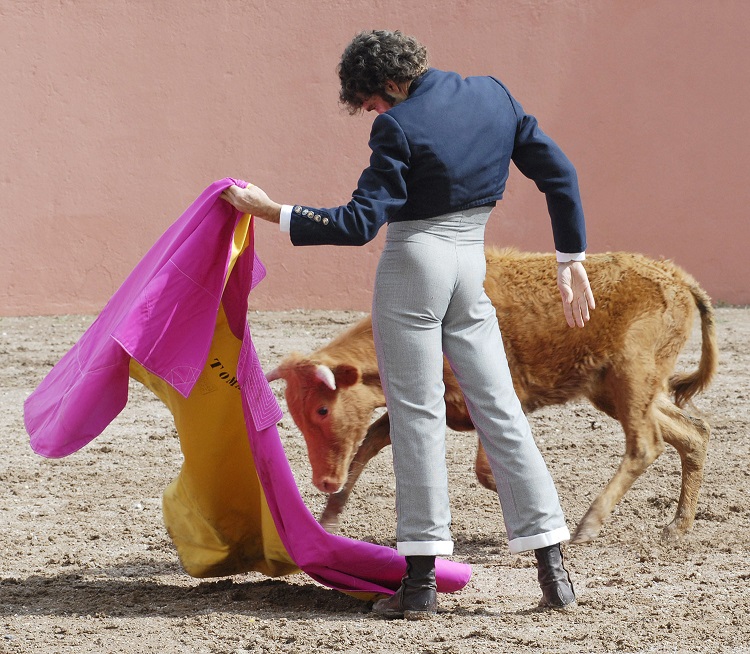Foto: Jose Tomas tentando a three-year-old calf
By Morgan
If you are fortunate to be invited to a bull breeding ranch in the spring, chances are you’ve been invited for a tienta of brave stock. The word tienta in bull speak means testing and all youngsters, both males and females, are tested.
They spend the first year of their lives with their mothers and for the second they are separated and spend the year frolicking with their fellows, butting heads while they learn to eat grass.
One afternoon at the bull breeding ranch of Barralva, which is located an hour from San Miguel de Allende, Julian Lopez, known as El Juli, was testing six novillos, three-year-old bulls, to see if they would serve as sementales, seed bulls. A three-year novillo is fleet of foot; for a few hundred yards he can outrun a quarter horse. and he’s agile. I’ve seen them jump a six-foot fence from a standing start.
The tentaderos are the private bull rings you find on all bull breeding ranches. During a testing, puerta is a word you will hear said in a strong voice by the ganadero, the bull breeder. Puerta means gate or door, and when the ganadero says it the tension mounts among the attendees and conversations stop. All eyes turn to the corral gate as it opens with a bang—it always opens with a bang—then a 500-pound arrogant three-year-old bull with six-inch horns and a bad attitude bursts into the arena!
A cuadrilla is a select group of people with specific jobs; they are the matador’s assistants: his team of picadors, banderilleros, chofers and a mozo de espadas, the sword keeper who is the matador’s right hand man. Juli’s mozo was Armando Gutierrez Galan and we had become friends. He knew that in times of need, he could always depend on me, and that somewhere in my photogs vest with its 23 pockets, there was always a flask with brandy.
I mention this because it was precisely at this time, the opening of the gate and the entrance of the fleet footed novillo into the plaza, that Armando stopped and asked for the flask. After he took a sip and returned the flask, I stood there with the flask in one hand and the cap in the other when the head and shoulders of the novillo appeared above Armando. The bull had jumped the fence and was coming down on top of us. OOPS!
I yelled, “Aguas!” (look out! in the calo, slang, of Mexican Spanish) and Armando disappeared as I stumbled to my right, cap in one hand, flask in the other, camera swinging freely from my neck and banging against the wooden barrier that was my refuge, as the novillo made a graceful lunge a few feet from me, his forelegs extended, his hands together (in Spanish the front feet of animals are referred to as hands, manos, the rear are feet, patas).
Fortunately, my camera bag distracted the beast and as he tarried with it, showing it his disdain with a few well-placed horn thrusts, he gave me the time to get behind the barrier. When he turned to me his six-inch horns found only wood to bang.
But before he left, he backed up and lifted his head for a last look at me. It was our quiet moment, just the two of us. Was he thinking, “almost got cha?” I know the ganadero was; he was sitting above me observing our private moment as the young bull walked away and he leaned over the barrier to say, “Almost Morgan, almost,” and then he laughed.
Whenever you’re around brave bulls never lose sight of them as I did, letting him disappear behind Armando. They will not forgive your foolishness!
I’m Morgan and I’ve been fascinated by brave bulls for sixty years. I currently have a show of my photography at the Instituto Allende. If you have any questions about the bulls, come by and we’ll talk about them. Most days from 10am–1pm, and 4pm–6pm.

